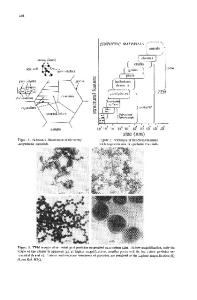Macrocellular Silica Monoliths Hierarchically Textured: Mesostructured Si-HIPE Materials
- PDF / 577,015 Bytes
- 6 Pages / 612 x 792 pts (letter) Page_size
- 93 Downloads / 308 Views
EE9.4.1
Macrocellular Silica Monoliths Hierarchically Textured: Mesostructured Si-HIPE Materials F. Carn,1 A. Colin2 and R. Backov1,* Centre de Recherche Paul Pascal CNRS UPR 8641, 115 Ave Albert Schweitzer, 33600 Pessac, France ; 2 Laboratoire du Futur, UMR CNRS-Rhodia FRE2771, IECB, 2 rue Robert Escarpit, 33607 Pessac, France. [email protected]
1
ABSTRACT Interface between sol-gel process and soft matter appears recently as a very nice tool to generate new materials with complex textures or/and structures extended at various length scales. In this general context, hierarchical inorganic porous monoliths have been prepared using a double templates procedure, namely concentrated emulsion as a macroscopic pattern and mesoscopic micellar templates. The texture of those monoliths can vary dramatically playing either with the oil volume fraction, synthetic pH conditions or the emulsification process. These materials show interconnected macroporosity associated to vermicular-type mesostructuration with an average mesoporosity of 800 m2/g associated to bulk density as low as 0.08 g cm-3 which is comparable to values obtained for silica aerogel. INTRODUCTION While inorganic materials mesostructuration seems today a rather well established approach [1] it appears an important issue to achieve a strong degree of control over higher scales leading to hierarchically organized structures. One interesting strategy is to maintain micellar organization at the mesoscale while promoting mineralization at macroscopic interfaces induced by metastable thermodynamic systems as air-liquid [2] or biliquid foams [3]. Other strategies of obtaining complex textures are based on the use of either preformed nanopatterning spheres [4] or micro-organism [5] enhancing the impact of the on-growing field of bio-inspired materials or chemistry of “shapes”[6]. In the specific context where metastable thermodynamic systems are used as macroscopic patterns, ordered macroporous inorganic materials have been generated using direct concentrated non aqueous [7] or aqueous emulsions[8]. In these approaches the authors aim to associate a high degree of ordered macroporosity associated inorganic walls as dense as possible, thus to achieve the maximal contrast in the refractive index between the matrix and the macropores, with emphases toward photo-band gap properties [9]. More recently, porous silica have been obtained based on the use of emulsions stabilized by silica particles in the absence of surfactants [10]. On the other hand, materials dedicated toward heterogeneous catalysis or phase separation properties should provide high internal surface. In this last issue distinct silica beads have been obtained with hierarchical porosity using emulsion-polymer double templates [11] or phase separation [12] and more recently our group has developed a new process to obtain macrocellular silica monoliths with a high degree of control over both cell sizes and morphologies [2]. In the present study, taking benefit of biliquid foams, we present a simple
Data Loading...










